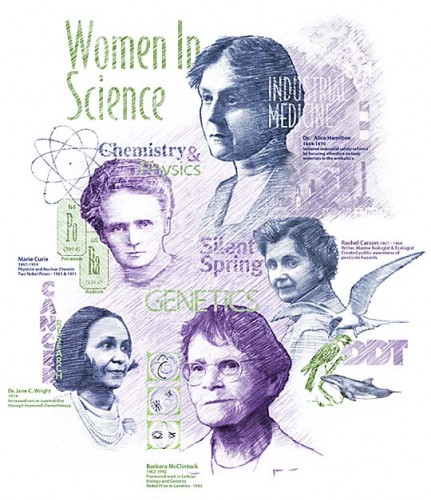 Contributed by Tara Fernandez, Postdoctoral Fellow at Conway lab, CBR
Contributed by Tara Fernandez, Postdoctoral Fellow at Conway lab, CBR
Considered a world-renowned authority on congenital heart disease in her time, Maude Abbott was among Canada’s earliest female medical graduates and researchers. Graduating as class valedictorian from McGill University in 1880, Abbott made several substantial advances in her field, publishing over 100 books and articles. Perhaps most admirable was her unwavering dedication to overcome the obstacles facing women in medical research at the time. Over a century on, significant breakthroughs in policies and general attitudes have created opportunities for women to take their place as equals on the research stage. A closer look at diversity among scientists in both research and industry, however, reveals that a gender disparity still exists.
Recent Canadian statistics indicate that women account for 59% of graduates from science and technology programs. These numbers, however, diminish rapidly at the senior academic and principal investigator levels. The representation of women at the professoriate and senior administration levels tapers off to just over 20%, in line with similar numbers seen in the UK, US, Australia and the EU. Even upon successfully obtaining a senior position in academia, women only take home 88% of the earnings compared to their male counterparts. Similarly, the lack of proportional representation is evident when it comes to leaders in the biotechnology industry. Studies have indicated that for the last five decades, women in the US never represented more than 10% of scientific advisory boards. Such demographic trends in research pose serious concerns to women starting out and wishing to rise through the ranks.
What are the main hurdles that women in science face? An issue that has persisted, particularly in the realm of academia, is the challenge women face in obtaining tenure-track positions in university. Implicit biases may come into play during the hiring process (often by male-dominated recruiting panels), leading to women with equally impressive resumes being ranked second-best to their male counterparts. Wenneras and Wold found that female postdoctoral researchers had to publish significantly more articles in high-ranking journals to obtain similar peer-reviewed academic rankings as male researchers.
Even after being hired, studies show that there is a significantly higher turnover rate for women in academia, with many picking alternative career paths instead. Interestingly, the workplace environment is often a major contributing factor to this phenomenon. Indeed, dissatisfaction with the culture and attitudes within the faculties, as well as insufficient leadership, funding and career advancement opportunities lead to women leaving academia.
The balance between career and family is often raised as being instrumental in women being under-represented or not going down traditional academic routes. Juggling equally demanding work and home duties, particularly childcare responsibilities, is a daily reality for many women researchers. While many are able to excel at both simultaneously, statistics point to gender disparities occurring over time for researchers in science and technology. Among professors who had babies within five years of their PhDs, for example, 77% of men achieved tenure 12 years after receiving their doctorates. In comparison, only 53% of women achieved the same success. To tackle this issue, employers should be mindful in facilitating the transition of women from career breaks for maternity or childcare. Stereotypes and attitudes may be changing in the academic landscape. However, it is a shared responsibility to ensure that women are not disadvantaged professionally because of their choices outside the workplace.
Women pursuing a career in science in Canada have access to a variety of resources. For example, the Society for Canadian Women in Science and Technology (SCWIST) consists of a vibrant community of members from both academia and industry, which promotes and assists women in research. The society provides members with numerous opportunities throughout the year for networking and professional development. In addition, SCWIST provides a mentorship database, www.makepossible.ca that connects women based on skills sought and skills offered. SCWIST also has a specialized program for immigrating women in science (IWIS) tailored towards women from the international research community. To get involved in promoting science as a career for girls, the ‘ms infinity’ wing of SCWIST organizes a variety of fun conferences and workshops for students. Volunteers act as positive role models through the eMentor scheme in a bid to bust outdated myths about scientists and encourage the next generation of young talent.
Promoting and retaining women in science and technology require a team effort involving individuals, employers, universities and governments. Also, increasing public awareness and championing those pursuing an academic research career is necessary to raise the profile of women in the university sector. Ultimately, creating a research community that promotes diversity and equality will take Canadian innovators to new levels of excellence.



